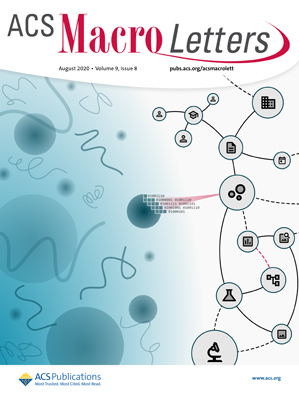原位核磁共振监测体光聚合动力学
IF 5.2
Q1 POLYMER SCIENCE
引用次数: 0
摘要
精确测量光聚合动力学的能力对于控制光固化系统中的固化特性和材料性能至关重要。用于测量动力学的传统方法,如实时傅里叶变换红外光谱(RT-IR),往往受到系统固有的展宽机制和较差的光谱分辨率的限制。在这项工作中,我们提出了一种原位核磁共振波谱技术来监测体光聚合反应,其中聚合物系统通过毛细管插入物与锁定溶剂分离,并使用led耦合光纤进行光激发。该技术允许对整体反应系统进行孤立观察,同时也受益于核磁共振提供的高光谱分辨率和丰富的化学信息。测定了纯丙烯酸己酯、甲基丙烯酸异硼酸酯、N、N-二甲基丙烯酰胺和交联剂丙烯酸己酯四种体系的相对速率常数(kp′)和最终单体转化率。通过观察简单光聚合物系统的动力学数据,本工作证明了原位核磁共振光聚合作为传统RT-IR和其他方法的补充技术在体光聚合物材料动力学监测中的实用性。本文章由计算机程序翻译,如有差异,请以英文原文为准。

In Situ NMR to Monitor Bulk Photopolymerization Kinetics
The ability to precisely measure photopolymerization kinetics is paramount to controlling curing characteristics and material properties in photocurable systems. Traditional methods used to measure kinetics, such as real-time Fourier-transform infrared spectroscopy (RT-IR), are often limited by broadening mechanisms intrinsic to the system and poor spectral resolution. In this work, we present an in situ NMR spectroscopy technique to monitor bulk photopolymerization reactions wherein the polymer system is separated from the locking solvent via a capillary insert and photoexcited using an LED-coupled fiber optic. This technique allows for the isolated observation of the bulk reaction system while also benefiting from the high spectral resolution and rich chemical information offered by NMR. Relative rate constants (kp′) and ultimate monomer conversion were determined for four systems: neat hexyl acrylate, isobornyl methacrylate, N,N-dimethylacrylamide, and hexyl acrylate with cross-linker. By observing kinetic data of simple photopolymer systems, this work demonstrates the utility of in situ NMR photopolymerization as a complementary technique to conventional RT-IR and other methods for the kinetic monitoring of bulk photopolymer materials.
求助全文
通过发布文献求助,成功后即可免费获取论文全文。
去求助
来源期刊
CiteScore
10.40
自引率
3.40%
发文量
209
审稿时长
1 months
期刊介绍:
ACS Macro Letters publishes research in all areas of contemporary soft matter science in which macromolecules play a key role, including nanotechnology, self-assembly, supramolecular chemistry, biomaterials, energy generation and storage, and renewable/sustainable materials. Submissions to ACS Macro Letters should justify clearly the rapid disclosure of the key elements of the study. The scope of the journal includes high-impact research of broad interest in all areas of polymer science and engineering, including cross-disciplinary research that interfaces with polymer science.
With the launch of ACS Macro Letters, all Communications that were formerly published in Macromolecules and Biomacromolecules will be published as Letters in ACS Macro Letters.

 求助内容:
求助内容: 应助结果提醒方式:
应助结果提醒方式:


